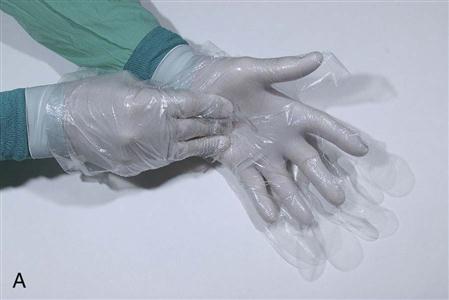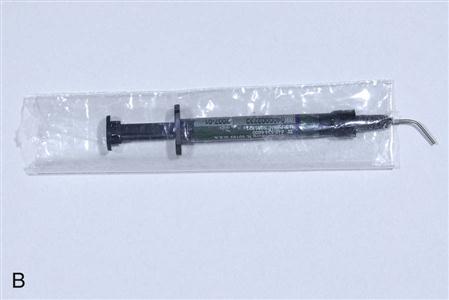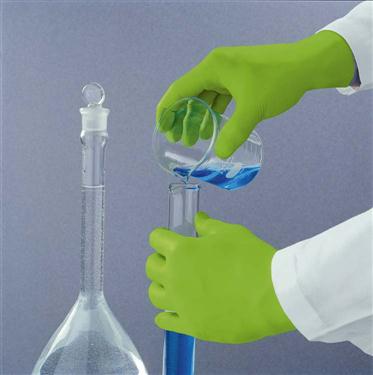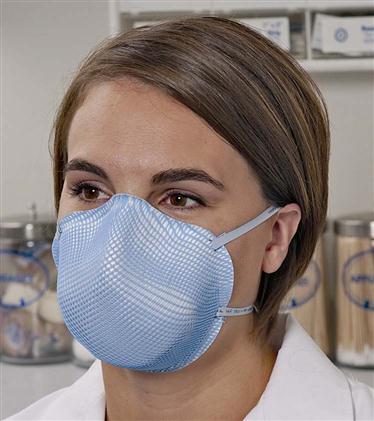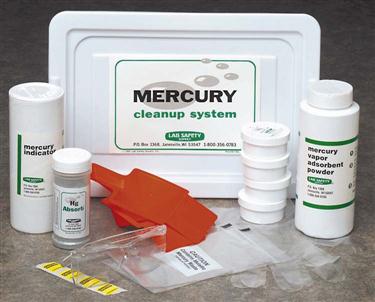General Handling and Safety
Chapter Objectives
On completion of this chapter, the student will be able to:
3. Describe the ways that chemicals can enter the body.
4. Describe the employee and employer responsibility for safety training.
KEY TERMS defined within chapter
Particulate Matter extremely small particles (e.g., dust from dental plaster or stone)
Personal Protective Equipment (PPE) gloves, masks, gowns, eyewear, and other protective equipment for the employee
Hazardous Chemical chemical that can cause burns to the skin, is poisonous, or can cause fire
Ignitable a material or chemical that can erupt into fire easily
Corrosive usually an acid or strong base that can cause damage to skin, clothing, metals, and equipment
Reactive the reaction of opposing chemical substances that creates a different end product
Material Safety Data Sheet (MSDS) printed product reports from the manufacturer containing important information about the chemicals, hazards, handling, cleanup, and special PPE related to a product
Splatter small particles that may contain blood, saliva, oral particulate matter, water, and microbes
The dental office worker uses a wide variety of materials that contain chemicals used for patient treatment and laboratory procedures. All chemicals are capable of causing harmful effects if they are absorbed into the human body in large enough amounts. The dental assistant and the dental hygienist must understand safe use, cleanup, and disposal methods for all of the materials used in the dental office. This chapter also discusses compliance with governmental regulations and explains health and safety procedures.
Materials Hazards in the Dental Environment
Exposure to Particulate Matter
During the manipulation of many dental materials, particulate matter can be generated. Items such as gypsum products, alginate, microblasting materials, and pumice may generate dust during handling. Gypsum models, processed acrylic, porcelain, and various restorative materials may generate dust during the grinding and polishing processes. It is important for each person who is handling and manipulating these materials to have and use the proper personal protective equipment (PPE) such as dust or surgical masks, eyewear, gowns, and (when appropriate) hair covering or tieback.
Exposure to Biological Contaminants
Dental personnel come in contact with a variety of microorganisms via exposure to blood, body fluids, or oral and respiratory secretions. These microorganisms may include hepatitis B virus (HBV), hepatitis C virus (HCV), human immunodeficiency virus (HIV), and other viruses and bacteria. Dental personnel can be protected from the occupational transmission of infectious diseases through strict adherence to the requirements of the Occupational Safety and Health Administration (OSHA) and the Canadian Center for Occupational Health (CCOH) Bloodborne Pathogen Standard, and to the infection control guidelines issued by the Centers for Disease Control and Prevention (CDC). A further excellent resource for the dental team is the Organization for Safety and Asepsis (OSAP). The dental assistant/hygienist must be familiar with these guidelines. In addition, some U.S. states have regulations specific to infection control for dentistry. Dental personnel must consider the possibility that any container or piece of equipment or dental material may become contaminated during handling. Thus it is important to use proper barrier protection such as overgloves or plastic covers when handling the bottles, cans, or tubes that contain many of the dental materials used in a modern dental practice (Figure 4-1).
Chemical Safety in the Dental Office
Hazardous Chemicals
A hazardous chemical is defined as any chemical that has been shown to cause a physical or health hazard. It can be any substance that can catch fire, react, or explode when mixed with other substances, or that is corrosive or toxic. It is the chemical manufacturers’ responsibility to assess the hazards of their products and pass this information on to consumers. Many dental materials contain more than one chemical.
Skin
The skin is an effective barrier for many chemicals; however, some chemicals are absorbed through the skin. In general, the skin must be in direct contact with the chemical for this to happen. Absorption also may occur directly through breaks in the skin such as cuts, open sores, or inflamed hands. After repeated contact with some chemicals, a skin disease called dermatitis may occur. Other chemicals, such as acids, can cause skin burns and are extremely harmful to the eyes.
Inhalation
Inhalation of gases, vapors, or dusts of materials is a common route of chemical exposure for dental personnel. Some chemicals can cause damage directly to the lungs. Other chemicals may not affect the lungs but are absorbed by the lungs and sent via the bloodstream to other organs such as the brain, liver, or kidneys, where they may cause damage. PPE such as masks or a proper respirator must be considered be used as appropriate for each procedure.
Ingestion
Ingestion (swallowing) is another way that chemicals can enter the body. Eating in an area where chemicals are used or eating with hands that are contaminated with chemicals is a common way of ingesting harmful chemicals. In the dental laboratory, many procedures are done that produce contaminants such as metal grindings and gypsum products. It is important to wash your hands thoroughly after contact with any chemical. In many cases, the use of special protective gloves is indicated, and they must be removed and the hands washed before food is handled.
Acute and Chronic Chemical Toxicity
The toxicity of a chemical, and thus its harmfulness, depends directly on the dose, length, and frequency of the exposure.
Acute Chemical Toxicity
Acute chemical toxicity results from high levels of exposure over a short time. This is frequently caused by a large chemical spill in which the exposure is sudden. The effects of this type of toxicity are felt right away. The symptoms of acute overexposure to chemicals include dizziness, fainting (syncope), headache, nausea, and vomiting.
Chronic Chemical Toxicity
Chronic chemical toxicity results from repeated exposures, usually to lower doses, over a much longer time such as months or even years. The effects of chronic toxicity can include cancer, neurologic deficits, and infertility.
For example, a single exposure to a high concentration of benzene may cause dizziness, headache, and unconsciousness; long-term daily exposure to low levels of benzene may eventually cause leukemia. Another example is that some of the metals used in partial denture frameworks contain beryllium. When grinding these frameworks for adjustment, one must avoid inhaling the dust because it is a toxic hazard that can lead to lung disease. A proper mask or respirator must be worn.
Personal Chemical Protection
Hand Protection
The latex gloves worn during patient care do not provide adequate protection when chemicals are handled. When exposed to chemical disinfectants, the latex in the gloves degrades and can actually pull contaminants and chemicals through the glove like a wick and onto the hands. Chemical-resistant gloves such as nitrile gloves are recommended for wear during chemical handling (Figure 4-2). Some individuals have developed a reaction to the latex products in the gloves. A proper dermatologic diagnosis is required before it can be determined whether the reaction is a chemical or latex reaction.
Eye Protection
Serious damage to the eyes, including blindness, can result from chemical accidents. It is necessary to protect the eyes from fumes and splashes while chemicals such as alcohol or methyl methacrylate monomer, acid, or other solvents are poured. The acids used for bonding procedures can be splashed into the eyes during rinsing from the etched teeth. Safety eyewear such as goggles with soft vinyl flanges at the top and bottom that fit the face snugly should be used. Protective eyewear with side shields and splash shields are available from many manufacturers and must be worn in patient care settings (Figure 4-3).
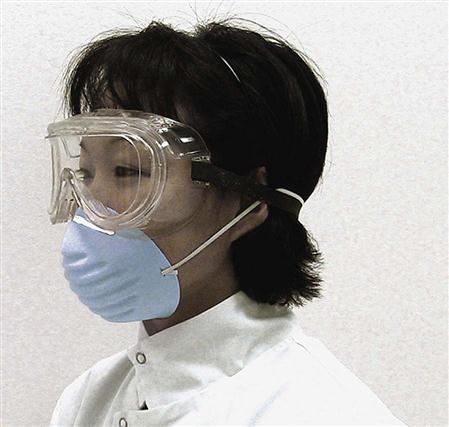
Protective Clothing
The type of chemical that is being used should guide the selection of protective wear. A rubber or neoprene apron should be worn when one is mixing or pouring chemicals that are caustic and can stain or would saturate and penetrate or damage regular fabric.
Inhalation Protection
Masks worn during patient care may or may not provide adequate protection when one is working with chemicals, depending on their quality. The facemask should be fluid repelling and provide respiratory protection. If the job requires frequent pouring or mixing of chemicals, sensitive or allergic individuals might need a National Institute of Occupational Safety and Health (NIOSH)–approved dust and mist respirator facemask (Figure 4-4).
Control of Chemical Spills
Mercury Spill
Mercury spill kits should be available in all dental offices that use amalgam for restorations (Figure 4-5). Exposure to even small amounts of mercury is very hazardous to workers’ health. Mercury can be absorbed through the skin or by the inhalation of mercury vapors.
The spill kit for small amounts of mercury should contain mercury-absorbing powder, mercury sponges, and a disposal bag. A mask and utility-type gloves should be worn whenever a mercury spill is cleaned.
Stay updated, free dental videos. Join our Telegram channel

VIDEdental - Online dental courses


